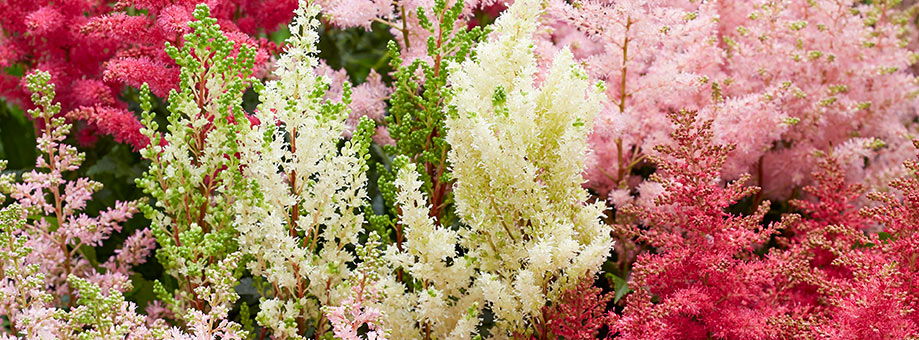- About Bulbs
- Landscaping Tips
- Planting & Care of Bulbs
- Tips for buying Bulbs & Perennials
- Planting & Growing Instructions
- Allium Planting and Growing Tips
- Astilbe Planting and Growing Tips
- Begonias Planting and Growing Tips
- Calla Lily Planting and Growing Tips
- Crocus Planting and Growing Tips
- Daffodil Planting and Growing Tips
- Dahlia Planting and Growing Tips
- Daylily Planting and Growing Tips
- Gladiolus Planting and Growing Tips
- Hosta Planting and Growing Tips
- Hyacinth Planting and Growing Tips
- Iris Planting and Growing Tips
- Lily Planting and Growing Tips
- Peony Planting and Growing Tips
- Rose Planting and Growing Tips
- Tulip Planting and Growing Tips
Haven't heard of astilbe? With fern-like foliage and feathery, plumed flower heads, this perennial is a secret weapon in the shade garden. Astilbe plants grow in shaded and woodland areas, making them ideal flowers for growing in those tough, darker spots in the landscape. Read on for a better understanding of how to care for astilbes!
What is an Astilbe?
Also known commonly as "false goat's beard" and "false spirea,"astilbes are hardy, low maintenance blooms that grow in shaded areas. These native-adjacent plants attract bees and butterflies and produce colorful, long-lasting flowers. Their green-gold foliage is notable, as are the dozens of soft flowers that sprout on each crested bloom. In Greek, the name Astilbe translates to "glittering" and alludes to the fact that the individual flowers of this species are small and inconspicuous.
Astilbes are the perfect filler plants—ideal for naturalizing or creating a beautiful backdrop, without fading into the background. Luckily, astilbes are also quite easy to grow, and tolerant of a variety of soil types and climates. These perennials are the perfect way to add life and vibrance to your shade garden.
How to Plant Astilbes?
The first step in planting: understanding the needs of the plant. While astilbes are quite tolerant, a bit of pre-planning can ensure you'll get the best blooms these plants can make. Let's talk about what astilbes require and how to plant them.
Astilbe plants grows best in partly shaded areas, but will produce the most flowers if it's provided with a bit of dappled or indirect light. Consider planting your astilbes under a tree or along the shaded side of a structure.
Astilbes prefer rich, organic type soil, so compost is an excellent amendment for these plants. While astilbes don't mind settling into shady locations, they don't like to be totally soaked ,so skip planting them in spots where water builds up. We also can't help but recommend our own food for perennial bulbs, which enriches the soil for your shade plants.
Once you've prepared the soil by adding compost and plant food, it's time to plant your astilbe plants. These plants typically ship in small pots, so remove the pot and and wrapping, and break up the roots if they've become potbound. Plant your perennials at the same depth to which they were potted, and check your individual variety for spacing needs. Water the astilbes in well, and continue to water at least twice per week throughout the growing season.
Where to Plant Astilbe?
Not only do astilbes thrive in low-light conditions, these are genuinely unique and beautiful plants. Astilbes blooms will have shiny, spiky foliage and can rise to 5 feet tall, depending on the species. Consider the mature height of these plants when choosing your variety and where to place them!
The low light needs of astilbe flowers make them some of the most popular plants for shade, and these plants will truly grow best in shaded areas. However, they can handle some sun, and may even perform better in dappled or indirect light. For best results, plant your astilbe plants in a location with about two hours of light per day.
These light requirements mean that astilbe plants pair beautifully with other flowering shade plants. Let taller astilbe tower over low ferns and toad lilies, or allow them to add color to your hosta garden. The possibilities in a shade garden are really limitless, once you've learned which plants work well for shade.
Keep in mind that astilbe flowers are hardy in Zones 3-8 (unsure of your zone? You can find your hardiness zone here!). That means that they'll come back year after year, especially when well-kept, in all but the hottest and coldest zones.
How to Care for Astilbes?
Astilbe flowers are truly easy care, so they're perfect for beginning gardeners and folks who just don't have hours to spend tending to their shade garden. These beautiful naturalizing plants are truly rewarding when kept tidy! Here are some quick tips for astilbe care:
Astilbe will thrive when provided the right light and nutritional conditions, and may even need to be divided every few years. No worries there—you'll end up with more beautiful plants!
What are Common Astilbe Pests & Diseases?
Although astilbes are remarkably pest and disease resistant, there are a few common issues you will want to look out for. Many of these potential pitfalls can affect most perennials—not just astilbes—so get familiar with them, and ward them off for the best growing season yet! Let's look at some common pests and diseases associated with astilbe plants:
While pests can be a pain across the garden, astilbes attract tons of beneficial insects that make any hassle well worth your while. Astilbe plants attract bees, butterflies, and moths, sure to both beautify your garden and create a pollinator habitat.
What are Popular Astilbe Varieties?
Red and pink astilbes are among the most beloved colours of astilbe, but these shade plants grow in a variety of colors and heights. Check our some of our favorite astilbe varieties:
No matter what you're looking for, you're sure to find an astilbe that meets the needs of your shade garden. No longer are those shady spots something to hide—make the dark corners of your garden a relaxing oasis from the sun with beautiful, highly-textured flowers.










